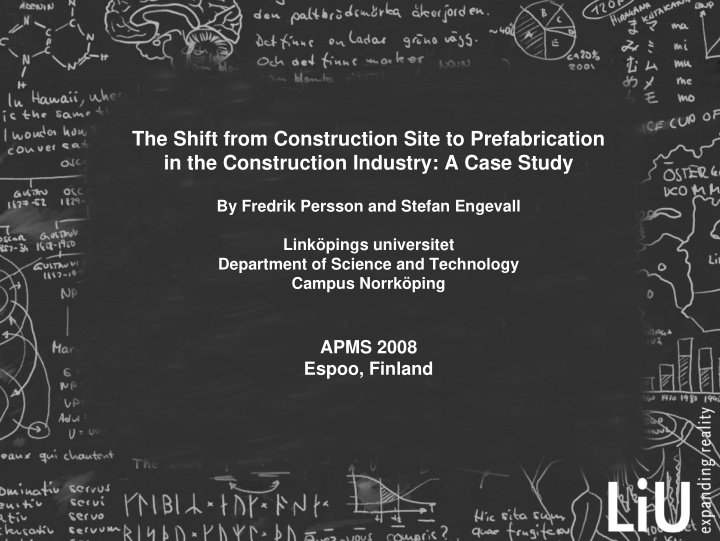



The Shift from Construction Site to Prefabrication in the Construction Industry: A Case Study By Fredrik Persson and Stefan Engevall Linköpings universitet Department of Science and Technology Campus Norrköping APMS 2008 Espoo, Finland
Content • The Construction Industry in Sweden • The Problem Area • The Product • Industrial House Building - Product and Process Matrix - Supply Chain - Customer Order Decupling Point - Planning System - Manufacturing Strategy • Conclusions and Outlook
Construction Industry in Sweden • Construction Industry (2007) - 68.000 companies - € 50.000 million turnover - 450.000 employees • Construction Companies (2007) - 24.000 companies - € 24.000 million turnover - 270.000 employees • Peab and SBE (Skandinaviska Byggelement) - € 3.500 million turnover - 12.000 employees
Problem Area • Problem - Houses are expensive to build – the price becomes high - Customers like low prices - Customers like low costs of living • Solution - Lower cost house production - Modularized concepts and prefabrication to lower production costs • Trend - Higher degree of modularization and prefabrication in house production • Purpose - Describe the shift from construction site to prefabrication
The Product On-site Built from modules On-site Built from raw materials In factory Built from raw materials Traditional house building Modularized / Prefabricated house building
Industrial House Building • Product and Process Matrix - Hayes and Wheelwright, 1979 • Supply Chain - Fisher, 1997 • Customer Order Decupling Point - Wikner and Rudberg, 2005 • Planning System - Berry and Hill, 1992 and Olhager et al ., 2001 • Manufacturing Strategy - Hill, 2000 and Hayes and Wheelwright, 1984
Product and Process Matrix Product structure & Product life cycle stages I. Low volume, II. Multiple III. Few major IV. High Process structure & Process life cycle stages low products, low products, higher volume, high standardisation, volume volume standardisation, one of a kind commodities I. Firm position 1. II. Jumbled flow (job shop) III. Disconnected line flow (batch) 2. IV. Connected 3. line flow Mismatch (assembly line) V. Continuous flow Implications: Lower flexibility with higher efficiency Source: Hayes and Wheelwright, 1979
The Right Supply Chain Product charateristics Functional Innovative Efficient Match charateristics Supply Chain responsive Market Match Implications: Lower cost supply chain Source: Fisher, 1997
Customer Order Decupling Point Site Supplier Construction Company CODP CODP Implications: Postponement of customer allocations Source: Wikner and Rudberg, 2005
The Planning System Product Characteristics: → Type of product Standard Special → Range of products Narrow Broad → Production volume per period High Low Levels of planning : Sales and operations planning (a) Level Chase Master production scheduling MTS ATO MTO Materials planning Rate based Time phased Production activity control Pull / JIT Push / MRP Implications: Utilize Lean production initiatives to reduce cost Source: Berry and Hill, 1992 and Olhager et al ., 2001
Manufacturing Strategy Order Winner Perceived Customer Price Value Price Felxibility Order Qualifier Acceptable Level Implications: New ways to compete on the market are necessary Better Characteristics Source: Hill, 2000 and Hayes and Wheelwright, 1984
Traditional House Building Site Supplier Raw material MTO/ETO CODP Supply chain configuration: Responsive Planning system: Time phased Production process: Project
Modularised / Prefabricated Site Supplier Raw material WIP Elements MTS MTO/ETO CODP Supply chain configuration: Efficient Responsive Planning system: Rate based Time phased Production process: Production line Project
Conclusions and Outlook • Traditional House Building - Construction Company: Peab - On site, time phased, responsive - High cost, long lead time • Modularized / Prefabricated House Building - Construction Company: SBE - In factory, rate based, efficient, postponement - Low cost, short lead time • Outlook - Supply Chain Structures (Sourcing) - Drivers for Industrial House Building (Production and Distribution) - Case Studies (Inwall)
Thank you! This research is sponsored by Brains & Bricks. In Brains & Bricks, Linköping University cooperates with Peab and the local authorities in the Katrineholm area. www.liu.se/b2
Recommend
More recommend